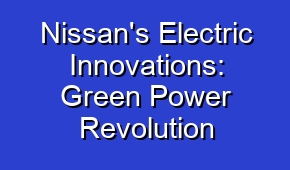Fuel-Saving Driving Habits

Summary: Save fuel by driving efficiently. Accelerate gradually, maintain a steady speed, avoid unnecessary idling, use cruise control, plan routes, and keep tires properly inflated.
Fuel-saving driving habits can significantly reduce your fuel consumption and save you money. By adopting these habits, you can maximize your vehicle’s fuel efficiency and minimize your carbon footprint. Firstly, maintaining a steady speed and avoiding rapid accelerations and decelerations can reduce fuel consumption. Secondly, avoiding excessive idling and turning off the engine when parked can also save fuel. Additionally, planning your trips efficiently by combining multiple errands into one can reduce unnecessary mileage. Furthermore, keeping your tires properly inflated and regularly maintaining your vehicle can improve fuel efficiency. Lastly, driving at a moderate speed and using cruise control on highways can further save fuel.
| Smooth acceleration and deceleration reduce fuel consumption. |
| Maintain a steady speed on highways to maximize fuel efficiency. |
| Regularly check and inflate tires to the recommended pressure for optimal fuel economy. |
| Avoid excessive idling to conserve fuel. |
| Combine errands and plan routes efficiently to minimize driving distance. |
- Turn off the engine when waiting for extended periods to save fuel.
- Use cruise control on highways to maintain a consistent speed.
- Avoid unnecessary weight in the vehicle to improve fuel efficiency.
- Service your vehicle regularly to ensure optimum fuel consumption.
- Drive at moderate speeds to reduce fuel consumption.
What are the most effective fuel-saving driving habits?
Fuel-saving driving habits play a crucial role in reducing fuel consumption and saving money. By incorporating efficient driving techniques, you can optimize your vehicle’s fuel efficiency.
Some effective fuel-saving driving habits include accelerating and decelerating smoothly to avoid unnecessary fuel waste. Avoiding rapid acceleration and hard braking can significantly improve fuel economy.
Properly maintaining your vehicle is also essential for fuel efficiency. Regularly checking tire pressure, engine oil, and air filters can help ensure optimal performance.
Reducing unnecessary weight in your vehicle can improve fuel economy as well. Removing excess cargo or rooftop storage can reduce drag and improve aerodynamics.
Another important fuel-saving habit is minimizing idle time. Avoiding long idling periods by turning off your engine when parked or waiting can conserve fuel.
How does driving at a steady speed save fuel?
Driving at a steady speed is one of the most effective ways to save fuel. Maintaining a consistent speed allows your vehicle to operate more efficiently.
When you drive at a steady speed, your vehicle can enter a fuel-saving mode where it uses less fuel. Frequent acceleration and deceleration waste fuel due to increased energy requirements.
By avoiding unnecessary speed fluctuations, you can reduce the need for rapid acceleration and hard braking, which consume more fuel.
Additionally, driving at a steady speed allows your vehicle’s cruise control feature to optimize fuel consumption by maintaining a consistent pace.
How can I improve fuel economy during highway driving?
Improving fuel economy during highway driving is crucial for long-distance trips. To maximize fuel efficiency:
1. Maintain a steady speed by using cruise control or keeping a consistent pace, reducing the need for frequent acceleration and deceleration.
2. Avoid excessive speed as higher speeds create more wind resistance, increasing fuel consumption.
3. Reduce unnecessary weight by removing rooftop cargo or unnecessary items, improving aerodynamics.
4. Plan your route to minimize traffic congestion and avoid unnecessary idling time.
5. Use air conditioning wisely as it can increase fuel consumption. Opt for natural ventilation whenever possible.
What are the benefits of carpooling for fuel efficiency?
Carpooling offers numerous benefits for fuel efficiency, including:
1. Reduced fuel consumption as multiple passengers share a single vehicle, reducing the number of cars on the road.
2. Decreased traffic congestion leads to smoother traffic flow, reducing idling time and fuel waste.
3. Lower greenhouse gas emissions due to fewer vehicles on the road, contributing to environmental preservation.
4. Cost savings as fuel expenses are divided among carpool participants, reducing individual expenses.
5. Social benefits such as fostering connections, reducing stress, and promoting teamwork among carpoolers.
What impact does aggressive driving have on fuel consumption?
Aggressive driving habits have a significant impact on fuel consumption, resulting in:
1. Decreased fuel efficiency due to rapid acceleration, hard braking, and frequent speed fluctuations.
2. Increased fuel wastage as aggressive driving requires more energy, burning fuel at a faster rate.
3. Higher maintenance costs as aggressive driving puts more strain on the vehicle’s components, requiring more frequent repairs.
4. Reduced engine lifespan due to increased wear and tear caused by aggressive driving habits.
5. Environmental impact with higher emissions contributing to air pollution and climate change.
What role does vehicle maintenance play in fuel-saving driving habits?
Vehicle maintenance is crucial for fuel-saving driving habits and overall fuel efficiency. Proper maintenance:
1. Ensures optimal engine performance by regularly checking and changing engine oil, air filters, and spark plugs.
2. Keeps tires properly inflated to reduce rolling resistance and improve fuel economy.
3. Maintains fuel system cleanliness by using high-quality fuel and periodically cleaning fuel injectors.
4. Addresses any mechanical issues promptly to prevent further damage and maximize fuel efficiency.
5. Enhances overall vehicle longevity by reducing wear and tear on components through regular maintenance.
How can I reduce fuel consumption while driving in the city?
To reduce fuel consumption while driving in the city, consider the following strategies:
1. Plan your trips efficiently to minimize unnecessary driving and avoid congested routes.
2. Utilize public transportation or walk/bike for short distances when feasible.
3. Avoid rush hour traffic by adjusting your schedule or using alternative routes.
4. Optimize your vehicle’s air conditioning usage by using the fan or opening windows instead.
5. Practice smooth acceleration and deceleration to minimize fuel waste caused by rapid speed changes.
How does maintaining proper tire pressure improve fuel efficiency?
Maintaining proper tire pressure is essential for improving fuel efficiency. Benefits include:
1. Reduced rolling resistance as underinflated tires create more friction, requiring more energy to move the vehicle.
2. Improved fuel economy as properly inflated tires reduce the energy needed to overcome rolling resistance.
3. Enhanced tire lifespan with even wear patterns, reducing the need for premature tire replacements.
4. Enhanced safety as properly inflated tires provide better traction and handling on the road.
5. Reduced carbon emissions due to improved fuel efficiency, contributing to environmental preservation.
What are the advantages of using cruise control for fuel efficiency?
Using cruise control offers several advantages for fuel efficiency:
1. Maintains a steady speed by automatically adjusting throttle input, reducing unnecessary speed fluctuations.
2. Optimizes fuel consumption by minimizing rapid acceleration and hard braking through consistent speed control.
3. Reduces driver fatigue as it eliminates the need for constant speed adjustments during long drives.
4. Enhances safety by promoting a consistent and predictable driving behavior on highways.
5. Improves overall driving experience as it allows drivers to relax and focus on the road ahead.
How can I minimize fuel consumption during stop-and-go traffic?
To minimize fuel consumption during stop-and-go traffic, follow these tips:
1. Maintain a safe distance from the vehicle in front to anticipate traffic flow and reduce unnecessary braking.
2. Avoid aggressive acceleration when traffic starts moving to prevent rapid fuel consumption.
3. Utilize technology such as traffic apps to identify alternative routes and avoid congestion.
4. Turn off the engine if you anticipate a prolonged stop, such as at a long traffic light or in heavy traffic.
5. Practice smooth braking and acceleration to minimize fuel waste caused by frequent speed changes.
What impact does vehicle weight have on fuel efficiency?
Vehicle weight has a significant impact on fuel efficiency due to several factors:
1. Increased energy requirements as heavier vehicles require more power to move, consuming more fuel.
2. Higher rolling resistance as added weight puts more strain on tires, resulting in increased fuel consumption.
3. Reduced aerodynamics as rooftop cargo or unnecessary items create drag, decreasing fuel efficiency.
4. Limited payload capacity as heavier vehicles may have less room for additional passengers or cargo.
5. Higher maintenance costs as excessive weight puts additional strain on various vehicle components.
How can I optimize fuel efficiency during winter driving?
To optimize fuel efficiency during winter driving, consider these tips:
1. Warm up your vehicle efficiently by idling for no more than 30 seconds before driving.
2. Remove snow and ice from the vehicle’s exterior to reduce drag and improve aerodynamics.
3. Use seat warmers instead of heating the entire cabin, reducing energy consumption.
4. Avoid unnecessary idling to conserve fuel, especially during warm-up periods.
5. Check and maintain tire pressure as cold temperatures can cause pressure loss, reducing fuel efficiency.
What are the benefits of using a fuel-efficient vehicle?
Using a fuel-efficient vehicle offers several benefits:
1. Reduced fuel expenses as fuel-efficient vehicles require less fuel per mile traveled.
2. Lower carbon footprint with reduced fuel consumption and greenhouse gas emissions.
3. Potential tax incentives or financial benefits for owning and operating fuel-efficient vehicles.
4. Enhanced resale value as fuel efficiency is a desirable feature in the used car market.
5. Contributing to environmental sustainability by minimizing reliance on fossil fuels and reducing pollution.
What factors affect fuel consumption in hybrid vehicles?
Fuel consumption in hybrid vehicles can be influenced by various factors, including:
1. Driving style with aggressive acceleration and braking leading to higher fuel consumption.
2. Battery charge level as hybrid vehicles rely on electric power for efficiency, depleting the battery affects fuel consumption.
3. Terrain and road conditions such as uphill climbs or rough surfaces can impact fuel economy.
4. Weather conditions including extreme temperatures, wind resistance, and precipitation affecting fuel efficiency.
5. Vehicle weight and cargo as added weight increases energy requirements and reduces fuel economy.
What are the advantages of using synthetic engine oil for fuel efficiency?
Using synthetic engine oil provides several advantages for fuel efficiency:
1. Reduced friction as synthetic oil has better lubricating properties, minimizing energy loss.
2. Improved engine performance due to better temperature stability and reduced engine wear.
3. Enhanced fuel economy as synthetic oil reduces internal friction, optimizing fuel consumption.
4. Longer oil change intervals compared to conventional oil, reducing maintenance costs and waste.
5. Environmental benefits as synthetic oil reduces oil consumption and pollution from oil production.
How can I track my fuel consumption to improve efficiency?
To track fuel consumption and improve efficiency, follow these steps:
1. Keep a record of your fuel purchases, noting the amount of fuel and mileage.
2. Calculate your fuel efficiency by dividing the distance traveled by the amount of fuel used.
3. Identify trends by comparing fuel efficiency over different driving conditions or maintenance intervals.
4. Monitor driving habits such as excessive idling, aggressive acceleration, or speeding.
5. Make adjustments to your driving style or vehicle maintenance based on the observed patterns.





















